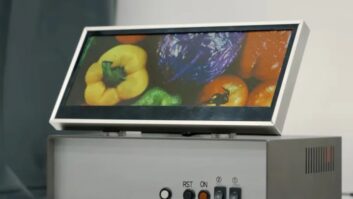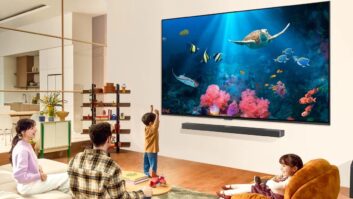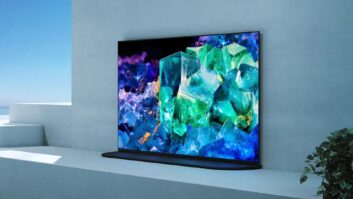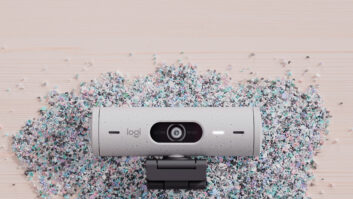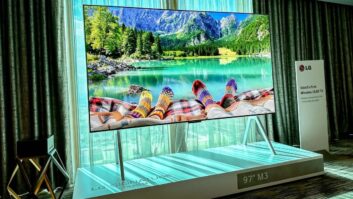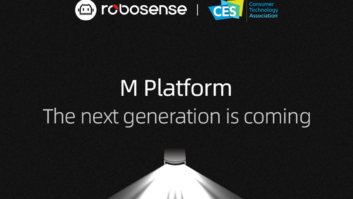TWICE: Many of the industry’s growth areas, like digital cameras and MP3 players, have now matured. What’s going to supplant them? Portable navigation comes to mind as one category in ascent.
Ross Rubin, The NPD Group: Yes, with very strong double-digit growth. We’re seeing more companies commit to the space — Panasonic announced it’s bringing Strada to the U.S., and Sony is releasing new models back into the market. There’s more activity from major CE manufacturers, but it’s been a tough market to crack. The top three vendors — Garmin, Magellan and TomTom — account for 80 percent-plus of the marketplace, and they’ve been hanging tough despite the entrance of many lower-priced SKUs.
There was quite a bit of promotion on those brands this past holiday season, but we really didn’t see the kind of marketplace position that the Mio brand achieved last year by undercutting everyone else by $100 and jumping into the No. 3 spot in unit share. There are more major manufacturers coming in, but the top three, at least for now, seem to have a pretty stable hold on the market.
Irynne MacKay, Circuit City: When you talk about saturation or maturation, it’s because the customer’s needs have basically been met in a way. For us the two big categories that did really well this past holiday season were gaming and GPS. You could say that portable navigation represents unmet needs. Once you try GPS, you can’t imagine going anywhere without it. With gaming, all of a sudden we have a whole new experience in social gaming. People that were hardcore gamers are picking up the Nintendo Wii or DS — typically that is the second console in the house. It’s an expansion to new needs. I read that some retirement homes are actually having Wii bowling as part of their weekly workout. That is clearly a new need.
Dan Schwab, D&H Distributing: It seems that as you look out at the next couple of years, the whole portable category, the all-in-one units, will continue to grow and evolve as Generation Y becomes the consumer. I think we’ll see more and more of these all-in-one units, such as a phone that also captures videos to share via YouTube, and which also holds photos and music.
Dave Workman, PRO Group: The next breakthrough in my opinion will be the ease of use, the GUI interface and software application, taking all of this technology that we have and putting it behind the curtain so that the consumer experience is elevated. I’ve always felt that this industry held itself back. It had tremendously more technology than consumers ever were able to absorb. So now we have multiple devices, portability and the interfacing of all of these technologies into your lifestyle, because consumer electronics isn’t a home system or a car system, it’s an everywhere system. If we think of the ecosystem of the consumer today, it’s “I want this stuff everywhere I am going be, when I want it and where I want it.” The infinite choice, and all of these other things we’ve talked about for years — the George Jetson possibilities — are really at our fingertips. But it’s going to require that we develop software that creates ease of use for the consumer to make that next breakthrough.
In doing so, you can’t pin yourself down to a home run product per se. We have a tendency to always think about that home run product, like high-definition television was. We’ve got to think about the business differently, to think about a multitude of products and the applications. When you do that, the increases and expansion of this business are endless in my opinion, because it will just continue to penetrate the lifestyle of the consumer that much more than it has in the past.
Schwab: The consumer wants the usage model. They want their entertainment. They want to be able to take it and share it. But there are still some impediments, like how to stream movies that you’ve downloaded from the Internet to multiple TVs. People still have an insatiable appetite for their entertainment and their communication. That’s not going to change. How our industry can provide that most effectively really is what increases and accelerates the rate of adoption.
Herschman: What we’re all really talking about is how to get content in a different way. It used to be that you would go to the store and buy a CD or a record and bring it home. Of course, millions of people still do that, but there are alternatives, and those alternatives are coming very fast. Amazon’s got three, including Unbox, where you avoid your computer entirely by using the network TiVo with your high-speed Internet connection, and you’re watching your movie on your television. You’re also taking it with you on your laptop or on your Unbox-designated portable device. We have a partnership with TiVo and we’ve got over 10,000 titles available.
The next one is the MP3 Store, where we have two million DRM-free titles, and the third one is Kindle, which uses a cellular type of network to download books, periodicals, blogs and all sorts of stuff no matter where you are.
I think this kind of change is going to be adopted much faster now because it’s been around for awhile, it’s become faster, and it’s more elegant. What Dave says is right, you do need to have a very simple customer interface. Apple has done an excellent job with that, and a lot of people are starting to follow suit. I think that is going to be one of the key catalysts to change over the next few years.
Fred Towns, New Age Electronics: The BlackBerry device that I carry in my pocket has everything including full navigation. I don’t need to take along a navigation unit or get one of the navigation services when I rent a car anymore. It’s in my phone now, with real-time traffic. When you consider that technology, and the unlocking of phones, the whole handheld side is going to be an interesting play. On business trips the question has become how few chargers I need to take. How can I stay in communication? Do I need to take a laptop or can I can get it on my handheld device? I think that solution, and tying the entertainment aspect into it, is going to be exciting.
MacKay: Portability is one of my categories at Circuit City, and what’s really exciting is not only that there are all of these new, different problems to solve, like how many chargers do you need, but also how the nature of content fundamentally changes. It’s not just prepackaged music, movies and games that someone else created. It’s user generated.
Another thing that’s really exciting about this space — and I think Apple taught all of us a lesson here — is that it’s not just about the technology. For a lot of people if it’s going to be portable and it’s going to be with you, it’s got to say something about you.
Workman: That’s where the aspirational aspect comes in.
MacKay: Now it actually has to look good when I take it out of my handbag, so it says something about you. It’s kind of like Prius owners: as much as they want to help the environment, owning the car also says something about them. I think the fun part of portability in the next couple of years is this customization around what the customers want, around what content means to them, and what the device says to them.
Workman: That’s the one element I hope we never lose in this industry. Apple, with the iPhone, has done as good if not a better job than anyone in creating that aspirational aspect, even in a tried and true commodity category like cellular phones. When someone pulls an iPhone out of their pocket, there’s someone special in the crowd. I would just hope that our group of manufacturers continues to focus on that. Growth has always followed those areas where the consumer is spending dollars on a very irrational basis because it helps them set the standard of who they are in the room. Portability is absolutely that. It’s not just what you have in your living room these days. It’s what you pull out of your purse.
Herschman: Irynne also makes a great point about creating your own content now. A really good seller for us is the Flip Video camera. We sold a lot. These things have a one-hour capacity flash drive, they’re very small, and you can take quick snippets of stuff. There’s software inside so that you can instantly upload it to your YouTube page.
Schwab: It’s intuitive. It’s very easy to use. That’s why it’s successful. People could upload videos for a long time.
Rubin: It’s not high definition.
TWICE: It’s good enough technology.
MacKay: It’s technology with a big impact.
David Smith, Ultimate Electronics: That goes back to Dave’s point about the convergence of all of these technologies and the simplicity of the interface. Even as Fred talks about using navigation in his phone, that’s not optimal navigation. I do the same thing as you, by the way. I could go out and spend money and get much better navigation and maybe have a better experience with that particular unit, but you don’t want to carry a bunch of chargers around. You don’t want to spend a lot of time, a lot of mind share trying to figure out how things work.
To a large degree content is very, very important, but at a point it’s good enough whether it’s low resolution going to YouTube as opposed to high resolution, or it’s the navigation that’s good enough to get you to your destination as opposed to the very, very best GPS device. What’s more and more important to users is the simplicity of the interface and a convergence of technology that actually works. We’ve talked about convergence for many years as an industry, but even with HDMI there is no standardization around that. One model doesn’t work with another brand, and it’s craziness. Consumers who are investing their dollars in this space oftentimes have less than perfect experiences. If we’re going to enhance people’s lifestyles, that part needs work. I think people compromise to get that.
Rubin: I just wanted to say a word about Apple, which is often held up as the model of effective hardware/software/services integration, which even has its own direct retail channel, and of course effectively fuses functionality and style. But Apple ultimately has a limited number of products in the marketplace. It’s much easier to do what they’ve done with that limited portfolio than it is for a Sony or a Samsung to do it across a range of hundreds of products with all different kinds of processors, operating systems and usage models.
That said, it’s hard for me to think of a single press conference at CES that did not see movement toward more integration and more attention to the software and functionality. To Dave’s [Workman’s] point, it’s software that is enabling wireless links between camcorders and televisions, it’s software behind Sony’s Cross Media Bar interface, and it’s software that’s driving the NAS [network-attached storage] products and a lot of the other functions that we’re seeing at the show.
TWICE: But when you have one product that replaces four or five, what does that do to your basket? Isn’t the industry going in the wrong direction here?
Workman: You can’t look at it that way. Look at the businesses that have been created out of the iPod. There’s a whole accessory industry that exists today that wouldn’t have had iPod not happened. I think there will always be customization and further selling opportunities as the consumer completes that lifestyle purchase. Maybe that is wishful thinking and a bit myopic, but I would hope that we can always have the opportunity to surround a catalyst product with a host of other products, which will ultimately keep us in business because there is margin in it. This business will always have margin pressure on that core demand product. Market dynamics will always deliver that model to you time and time again — demand equals margin pressure equals average selling price decline. But then on top of that you should always have all of these other little products that kind of grab on to that main product and build business around that.
Maybe it isn’t even a physical product. As you get into more of the software stuff, maybe another one of those value-added components is service, because you have this technology that you’re trying to put into the consumer’s home. Circuit City, Best Buy — these guys understand that it’s about how you deliver the complete solution to the consumer, not just the individual product.
Jeannette Howe, Nationwide Marketing Group: I think the complete solution is going to be home automation. The specialty retailer can’t sell products like this and make money on them. They need to be able to integrate the solution into the home, and if you look at the research on home automation, right now it’s a $14 billion, $15 billion business nationally. In the next five years, it’s going to grow to be an $85 billion business. In 10 years, the incandescent light bulb as we know it will no longer exist. There are huge opportunities to get into every aspect of a customer’s home with appliance, lighting, window treatment and security integration, which we’re going to have to usher those clients through. In the end, the growth is only as good as we can make it seamless for that customer.




